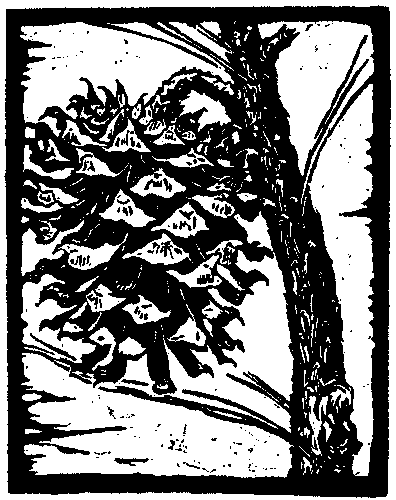
Digger Pine Cone
Slightly Less Than 1/2 Natural Size
| Online Library: | Title | Author | California | Geology | History | Indians | Muir | Mountaineering | Nature | Management |
Yosemite > Library > Trees > Digger Pine >
Next: Lodgepole Pine • Contents • Previous: Jeffrey Pine
Pinus sabiniana Dougl.

Digger Pine Cone Slightly Less Than 1/2 Natural Size |
The Digger Pine is the characteristic pine of the foothills—the Upper Sonoran Zone. With its gray, rather scanty foliage, it is depressing rather than inviting; on the brown and dusty hills of summer. The cone is its most attractive feature.
It takes its common name from the local appellation for the Indian tribes of the region—“Digger,” because much of their food consisted of roots and bulbs. The nuts of the Digger Pine were another of their main sources of food supply. It is also known as “Gray Pine” or “Blue Pine.” It will be noted from the scientific name that this is another of the trees which David Douglas described and classified; he named it for a friend.*
The Digger Pine occurs frequently up to the El Portal region, though around Mariposa, for example, it gives way to the Ponderosa Pine. At just about the Park boundary, the line of demarcation is rather sharply drawn; this tree is, therefore, a borderline tree of the Yosemite National Park rather than an established denizen of that area.
It reaches a height of from forty to seventy-five feet, and a diameter varying from one to four feet. Occasionally the main trunk is the axis from roots to crown, but the more typical shape of the tree has the trunk dividing at a height of from fifteen to twenty-five feet into a number of slender branches sent upward in an irregularly rounded form.
The needles, in clusters of three, are from seven to twelve inches in length; their grayish-green color is one of the distinguishing features of the tree.
The cones, which grow on stalks a couple of inches in length, are from six to ten inches long and five to seven inches through. They are heavy, compact, and strongly built, with the triangular tips of the firm scales developed into hooks. They remain on the tree for a long time after the seeds fall—from one to six or seven years—and leave the base of the cone attached to the tree, with a few of the basal scales.
The grayish hue of the foliage, the vertical clusters of branches, and the large cones with their hooked scale-tips are ready guides in distinguishing this tree from the Ponderosa Pine. It differs from all our other pines in its airy, open crown.
* Jepson, The Trees of California, page 45: “Digger Pine was discovered by David Douglas, during his travels in California in 1830 and 1831. He named it Pinus sabiniana in honor of Joseph Sabine, secretary of the London Horticultural Society, the organization which sent the Scotch explorer to California.
Next: Lodgepole Pine • Contents • Previous: Jeffrey Pine
| Online Library: | Title | Author | California | Geology | History | Indians | Muir | Mountaineering | Nature | Management |
http://www.yosemite.ca.us/library/trees_of_yosemite/digger_pine.html